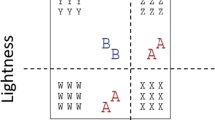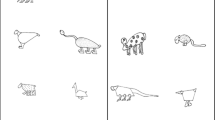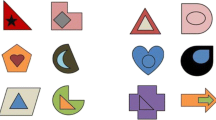Abstract
Exemplar models of categorization, which assume that people make classification decisions based on item information stored in memory, typically assume that all of the exemplars are available and inform decision-making. However, in this study, we hypothesized that people may selectively emphasize subsets of exemplars, giving rise to individual differences in categorization. To verify this hypothesis, we adopted the partial-XOR category structure in Conaway and Kurtz (Psychonomic Bulletin & Review, 24, 1312–1323 2017), which has been evident to be able to induce two major response patterns in the transfer phase: the Proximity and XOR patterns. “Experiment 1” confirmed that these two patterns could be generated if participants were trained with only the exemplars of one category or the other. In “Experiment 2”, participants were asked to not only learn the category labels of all exemplars but also memorize the exemplars of only Category A (Condition A), only Category B (Condition B), or two categories (Condition AB) for a recognition test after the training phase of the categorization task. As expected, in the transfer phase, the participants tended to perform the XOR and Proximity patterns, when the exemplars of Category A and Category B were respectively targeted for the recognition test. The parameters of the SDGCM estimated by Bayesian inference for modeling the data of “Experiment 2” showed that the exemplar accessibility of Category A was larger than that of Category B for performing the XOR pattern and vice versa for performing the proximity pattern, hence verifying our hypothesis.





Similar content being viewed by others
Open Practices Statement
The data and codes are available at https://osf.io/t9e6k/?view_only=f729f30209694007a061d69cc9eb74fa.
Notes
The similarity between two items is the negative exponential function of the distance between them.
We have tried a batch design in which participants underwent all training blocks and then all review blocks in another experiment. The results remained the same.
Exemplars within a category share a same accessibility.
References
Ashby, F. G., & Gott, R. E. (1988). Decision rules in perception and categorization of multidimensional stimuli. Journal of Experimental Psychological: Learning, Memory, and Cognition, 14, 33– 53.
Ashby, F. G., & Maddox, W. T. (1993). Relations between prototype, exemplar, and decision bound models of categorization. Journal of Mathematical Psychology, 37, 372–400.
Austerweil, J. L., Liew, S., Conaway, N. B., & Kurtz, K. J. (2019). Creating something different: Similarity, contrast, and representativeness in categorization
Bowman, C. R., & Zeithamova, D. (2022). Training set coherence and set size effects on concept generalization and recognition. Journal of Experimental Psychology: Learning, Memory, and Cognition, 46(8), 1442–1464.
Cohen, A., Nosofsky, R., & Zaki, S. (2001). Category variability, exemplar similarity, and perceptual classification. Memory & Cognition, 29, 1165–1175.
Conaway, N., & Kurtz, K. J. (2017). Similar to the category, but not the exemplars: A study of generation. Psychonomic Bulletin & Review, 24, 1312–1323. https://doi.org/10.3758/s13423-016-1208-1
De Schryver, M., Vandist, K., & Rosseel, Y. (2009). How many exemplars are used? Explorations with the Rex Leopold I model. Psychonomic Bulletin & Review, 16(2), 337–343.
Denton, S. E., Kruschke, J. K., & Erickson, M. (2008). Rule-based extrapolation: A continuing challenge for exemplar models. Psychonomic Bulletin & Review, 15(4), 780–786.
Erickson, M. A. (2008). Executive attention and task switching in category learing: Evidence for stimulus-dependent representation. Memory and Cognition, 36, 749–761.
Erickson, M. A., & Kruschke, J. K. (1998). Rules and exemplars in category learning. Journal of Experimental Psychological: General, 127, 107–140.
Hsu, A. S., & Griffiths, T. E. (2010). Effects of generative and discriminative learning on use of category variability. In S. Ohlsson & R. B. Catrambone (Eds.), Proceedings of the 32nd annual conference of the cognitive science society. TX: Cognitive Science Society, Austin. Available at SSRN: https://ssrn.com/abstract=1802162
Jamieson, R. K., Holmes, S., & Mewhort, D. J. K. (2010). Global similarity predicts dissociation of classification and recognition: Evidence questioning the implicit-explicit learning dissociation in amnesia. Journal of Experimental Psychology: Learning, Memory, and Cognition, 36, 1529–1535.
Knowlton, B. J., & Squire, L. R. (1993). The learning of categories: Parallel brain systems for item memory and category knowledge. Science, 262, 1747–1749.
Kruschke, J. K. (1992). ALCOVE: An exemplar-based connectionist model of category learning. Psychological Review, 99, 22–44.
Kurtz, K. J. (2007). The divergent autoencoder (DIVA) model of category learning. Psychonomic Bulletin & Review, 14, 560–576.
Lin, D. L., & Little, D. R. (2023). Further tests of sequence effects in a modified Garner task using separable dimensions. Journal of Experimental Psychology: General, 152, 1080–1121.
Little, D. R., Wang, T., & Nosofsky, R. M. (2016). Sequence-sensitive exemplar and decision-bound accounts of speeded-classification performance in a modified Garner-tasks paradigm. Cognitive Psychology, 89, 1–38.
Nosofsky, R. M. (1986). Attention, similarity, and the identification-categorization relationship. Journal of Experimental Psychological: General, 115, 39–57.
Nosofsky, R. M., Clark, S. E., & Shin, H. J. (1989). Rules and exemplars in categorization, identification, and recognition. Journal of Experimental Psychology: Learning, Memory, and Cognition, 15, 282–304.
Nosofsky, R. M., & Hu, M. (2022). Generalization in distant regions of a rule-described category space: A mixed exemplar and logical-rule-based account. Computational Brain & Behavior, 5, 435–466.
Nosofsky, R. M., Little, D. R., & James, T. W. (2012). Activation in the neural network responsible for categorization and recognition reflects parameter changes. PNAS, 109, 333–338.
Nosofsky, R. M., & Meagher, B. J. (2022). Retention of exemplar-specific information in learning of real-word high dimensional categories: Eviden from modeling of old-new recognition. Proceedings of the Auunal Meeting of the Cognitive Science Society, 44, 100–106.
Nosofsky, R. M., Palmeri, T. J., & McKinley, S. C. (1994). Rule-plus-exception model of classification learning. Psychological Review, 101, 53–79.
Nosofsky, R. M., & Zaki, S. R. (1998). Dissociations between categorization and recognition in amnesic and normal individuals: An exemplar-based interpretation. Psychological Science, 9(4), 247–255.
Palmeri, T. J., & Flanery, M. A. (1999). Learning about categories in the absence of traing: Profound amnesia and the relationship between perceptual categorization and recognition memory. Psychological Science, 10(6), 526–530.
Peirce, J. W. (2007). Psychopy-psychophysics software in python. Journal of Neuroscience Methods, 162, 8–13.
Rips, L. J. (1989). Similarity, typicality, and categorization. In S. Vosniadou & A. Ortony (Eds.), Cambridge University Press, New York, US
Sakamoto, Y., Jones, M., & Love, B. C. (2008). Putting the psychology back into psychological models: Mechanistic versus rational approaches. Memory & Cognition, 36(6), 1057–1065.
Shen, J., & Palmeri, T. J. (2016). Modeling individual differences in visual categorization. Visual Cognition, 24 (3), 260–283. https://doi.org/10.1080/13506285.2016.1236053
Smith, J. D., & Minda, J. P. (2000). Thirty categorization results in search of a model. Journal of Experimental Psychology: Learning, Memory, and Cognition, 26(1), 3–27.
Stewart, N., & Brown, G. D. A. (2005). perceptual categorization. Journal of Mathematical Psychology, 49, 403–409.
Stewart, N., Brown, G. D. A., & Chater, N. (2002). Sequence effects in categorization of simple perceptual stimuli. Journal of Experimental Psychology: Learning, Memory, and Cognition, 28(1), 3–11.
Stewart, N., & Chater, N. (2002). The effect of category variability in perceptual categorization. Journal of Experimental Psychology: Learning, Memory, and Cognition, 28, 893–907.
Yang, L.-X., & Huang, T.-L. (2021). Exemplar account for category variability effect: Single category based categorization. In Proceedings of the Annual Meeting of the Cog- nitive Science Society, 43, 2699–2705.
Zaki, S. R., & Nosofsky, R. M. (2001). Exemplar accounts of blending and distinctiveness effects in perceptual old-new recognition. Journal of Experimental Psychology: Learning, Memory, and Cognition, 27(4), 1022–1041.
Zaki, S. R., & Nosofsky, R. M. (2007). A high-distortion enhancement effect in the prototype-learning paradigm: Dramatic effects of category learning during test. Memory & Cognition, 25, 3088–3096.
Funding
The raw data and R codes are available at https://osf.io/t9e6k/?view_only=f729f30209694007a061d69cc9eb74fa and this study was not preregistered
Author information
Authors and Affiliations
Corresponding author
Additional information
Publisher's Note
Springer Nature remains neutral with regard to jurisdictional claims in published maps and institutional affiliations.
Appendix: Computational modeling with the SDGCM
Appendix: Computational modeling with the SDGCM
The SDGCM (Stewart & Brown, 2005) is an exemplar model, in which categorization is based on the similarity and dissimilarity of the to-be-classified item to all exemplars. As is the same as most exemplar models, the SD-GCM also assumes that each item is represented as a dot in the psychological space and the distance between items \(x_i\) and \(x_j\) is computed as \(d_{ij} = (\sum _m \alpha _m (|x_{mi} - x_{mj}|^p))^{1/q}\), where \(\alpha _m\) is the selective attention on dimension m, \(\sum _m \alpha _m = 1\). The parameters p and q determine the distance metric (e.g., \(p = q = 1\) for the city-block distance and \(p = q = 2\) for the Euclidean distance). We tried and found that the SDGCM could better generate our observed data in our two experiments when the Euclidean distance was used. The similarity between \(x_i\) and \(x_j\) is transferred from the distance between them as \(S_{ij} = e^{-cd_{ij}}\), where c is the specificity of the stimulus space; the larger c, the more specific each item is. The dissimilarity between \(x_i\) and \(x_j\) is computed as \(DS_{ij} = 1 - S_{ij}\). The probability that an item is classified as Category A is computed as \(P(A) = \frac{(\beta _A\nu _A)^\gamma }{(\beta _A\nu _A)^\gamma + (\beta _B\nu _B)^\gamma }\), where \(\nu _A\) and \(\nu _B\) are the valences for Category A and Category B, respectively, and \(\gamma \) is the decision parameter; the larger \(\gamma \), the more deterministic the categorization decision is. The bias parameters \(\beta _A\) and \(\beta _B\) were set as equal in this study, for the exemplars of the two categories were presented equally frequently.
The valence for Category A \(\nu _A\) is the sum of the total similarity of \(x_i\) to all exemplars of Category A and the total dissimilarity of it to all exemplars of Category B, as \(\nu _A = \sum _{j \in A}w_j S_{ij} + \sum _{j \in B}w_j DS_{ij}\), where \(w_j\) (\(0 \le w_j \le 1\)) is the parameter to weight the contribution of the exemplar \(x_j\) for categorization, which was treated as the accessibility of the exemplar \(x_j\) in this study. Likewise, the valence for Category B is computed as \(\nu _B = \sum _{j \in B}w_j S_{ij} + \sum _{j \in A}w_j DS_{ij}\). According to the SD-GCM, an item tends to be classified as one category if it is more similar to the exemplars of that category and more dissimilar to those of the contrasting category. In this study, it was assumed that the exemplars in the same category share the same accessibility. Thus, in “Experiment 1”, we estimated two accessibilities \(w_A\) and \(w_B\) for Category A and Category B, respectively. In “Experiment 2”, the accessibility of each exemplar was set up as 1, as there was only one category and no need to assess the exemplar accessibility of each category. Regardless of the experiment, the parameters of the SD-GCM were estimated by Bayesian inference, which was conducted by using the R package {rjags} with two chains each collecting 1000 posterior samples for each parameter and each response of the SDGCM, without setting up burn-in samples.
Bayesian modeling with the SDGCM for Experiment 1
In “Experiment 1”, four parameters, c, \(\gamma \), \(\alpha _x\), and \(\lambda \) were estimated for the data of each participant in the two conditions. The first three had uniform priors, as \(c\sim U(1,10)\), \(\gamma \sim U(1,20)\), and \(\alpha _x\sim U(0,1)\). As the data in “Experiment 2” were the probability of Category A (or 1 - Probability of Category B for Condition B) for each transfer item predicted by the participants, the likelihood for the SDGCM to generate each data point was computed by a Gaussian distribution function with the mean as the Probability of Category A computed by the SD-GCM for each transfer item and the precision as \(\lambda = 1/\sigma ^2\), where \(\sigma ^2\) is the variance of normal distribution. The precision parameter \(\lambda \) had a Gamma prior, \(\lambda \sim Gamma(0.001,0.001)\).
Bayesian modeling with the SDGCM for Experiment 2
Five parameters c, \(\gamma \), \(\alpha _x\), \(w_A\), and \(w_B\), were estimated for each participant in the XOR and Proximity groups. The first three had uniform priors as \(c\sim U(1,30)\), \(\gamma \sim U(3,20)\), and \(\alpha _x\sim U(0,1)\). The parameters \(w_A\) and \(w_B\) also had uniform priors, except that their intervals depended on the latent parameter g, which had a Bernoulli prior, \(g \sim Bern(0.5)\). When \(g = 0\) (for the XOR group), \(w_A \sim U(0.51,1)\) and \(w_B\sim U(0,0.49)\), while when \(g = 1\) (for the Proximity group), \(w_A\sim U(0,0.49)\) and \(w_B\sim U(0.51,1)\), as it was hypothesized that the XOR pattern and the Proximity pattern, respectively, result from referencing more Category A and Category B. The parameters \(w_A\) and \(w_B\) independently estimated, because it was not necessary to assume the total accessibility as a constant. The likelihood for the SDGCM to generate the observed response for each transfer item for each participant was computed by the binomial distribution function, given the probability of Category A computed by the SDGCM.
Rights and permissions
Springer Nature or its licensor (e.g. a society or other partner) holds exclusive rights to this article under a publishing agreement with the author(s) or other rightsholder(s); author self-archiving of the accepted manuscript version of this article is solely governed by the terms of such publishing agreement and applicable law.
About this article
Cite this article
Yang, LX., Chiang, PA. Post-training flexibility in category learning. Psychon Bull Rev (2024). https://doi.org/10.3758/s13423-023-02451-7
Accepted:
Published:
DOI: https://doi.org/10.3758/s13423-023-02451-7




